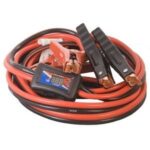Charging your car battery correctly is crucial for its longevity and performance. Using a 10 amp charger is a common and effective method, especially for lead-acid and AGM batteries. Understanding how long to charge your battery at this amperage is essential to avoid damage and ensure a full charge. This guide provides a detailed explanation to help you charge your car battery safely and efficiently.
Understanding the Basics of Car Battery Charging
To determine the charging time, you first need to understand the relationship between your battery’s amp-hour (Ah) rating and the charger’s amperage. The amp-hour rating indicates how much charge your battery can store. A 10 amp charger delivers 10 amps of current per hour.
The simplest way to estimate the charging time is to divide the battery’s Ah rating by the charger’s amperage (10 amps in this case).
Formula: Charging Time (in hours) = Battery Amp-Hour (Ah) Rating / Charger Amperage (10 amps)
For example, if you have a 50Ah car battery, the calculation would be:
Charging Time = 50Ah / 10 amps = 5 hours
This formula provides a theoretical maximum charge time. However, it’s important to consider that batteries are not 100% efficient in charging, and charging speed slows down as the battery nears full capacity.
Lead-Acid vs. AGM Batteries: Charging Considerations
The type of battery you have also influences the charging process. Most car batteries are lead-acid, but Absorbed Glass Mat (AGM) batteries are becoming increasingly common, especially in modern vehicles with start-stop systems or higher electrical demands.
- Lead-Acid Batteries: These are more tolerant of traditional charging methods. Using a 10 amp charger for a slow, controlled charge is beneficial for their lifespan.
- AGM Batteries: AGM batteries are more sensitive to overcharging and high charging rates. Slow charging is highly recommended for AGM batteries to prevent damage to their internal plates. Fast charging can lead to overheating and reduced battery life, as highlighted in experiences where improper fast charging of AGM batteries resulted in battery failure.
Alt text: Close-up of a car battery with visible terminals and labels, emphasizing the importance of battery maintenance for vehicle owners.
Step-by-Step Guide to Charging Your Car Battery at 10 Amps
- Safety First: Wear safety glasses and gloves. Ensure the charging area is well-ventilated.
- Disconnect the Battery (Optional but Recommended): For optimal safety and to prevent any electrical issues with your car, disconnect the negative terminal first, then the positive. If you are charging in-vehicle, ensure the car is turned off and no accessories are running.
- Connect the Charger: Connect the red (positive) clamp of the 10 amp charger to the positive terminal of your battery and the black (negative) clamp to the negative terminal.
- Set the Charger to 10 Amps: Ensure your charger is set to deliver a 10 amp charging rate. Some chargers may have adjustable settings.
- Start Charging: Turn on the charger.
- Monitor Charging Time: Use the formula mentioned earlier as a guideline. For a 50Ah battery, aim for around 5-6 hours of charging.
- Check Battery Charge (Hydrometer – for Lead-Acid Batteries): For traditional lead-acid batteries, using a hydrometer is a reliable way to check the state of charge. A hydrometer measures the specific gravity of the battery electrolyte, indicating charge level.
- Avoid Overcharging: Do not leave the battery charging indefinitely. Overcharging can damage any type of car battery, especially AGM. Once you estimate the charge time is complete, or the hydrometer reading is optimal for lead-acid batteries, disconnect the charger.
Why Slow Charging at 10 Amps is Beneficial
- Extends Battery Life: Slow charging at 10 amps is gentler on battery plates, reducing stress and heat buildup, which in turn prolongs the battery’s lifespan.
- Prevents Plate Warping: Fast chargers can generate excessive heat, potentially warping the internal plates of the battery, as experienced with quick charging attempts that led to battery failure shortly after.
- Better for AGM Batteries: As mentioned earlier, AGM batteries particularly benefit from slow charging to avoid damage to their sensitive components.
- Fuller Charge: Slow charging often results in a more complete and even charge throughout the battery cells.
Avoiding Fast Chargers
While fast chargers can quickly boost a battery, they are generally not recommended for regular car battery maintenance. They are best used in emergency situations when you need a quick charge to start your vehicle. Regular use of fast chargers can be detrimental to battery health, potentially leading to issues like plate warping and reduced battery capacity over time.
Conclusion
Charging your car battery at 10 amps is a safe and effective method, especially for lead-acid and AGM types. By understanding your battery’s amp-hour rating and following the guidelines for charging time and monitoring, you can ensure optimal battery health and longevity. Slow charging at 10 amps provides a gentler, more complete charge, helping you avoid the pitfalls of fast charging and maximizing the lifespan of your car battery. Remember to prioritize safety and monitor the charging process for the best results.

